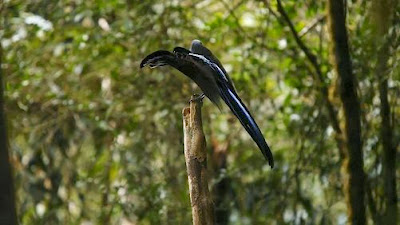 |
| Male Black Sicklebill |
Epimachus Fastosus:
As
the name implies , Black Sicklebill a large bird of paradise, with a long ,
strong, curved beak. The tail is immensely long, these are largest plumed birds
of paradise, colorful and richly decorated family and is known for the species
. The Black Sicklebill (Epimachus Fastosus) male reaching up to 110 cm in length,
and female is 48 cm long. The male Black Sicklebill is the longest member of Paradisaeidae family. Most
members of this family of birds, male black sicklebills are remarkably larger
and more gorgeous in outlook than females, they are rich black in colour but
show a beautiful metallic green and purple iridescence in certain light
conditions. Females are filled with chestnut brown margins. The underparts are off white
and feature sensitive dark-brown stripping. In both male & female, they have reddish
brown eyes . Black Sicklebill males generate Quik
nasal fluid contacts, call for QUIK. |
| Male Black Sicklebill |
Behaviour:
From 1522 to 1924, the birds of paradise skins brought
to Europe in large quantities. Remove the skin of their feet as always,
because Europeans thought, mistakenly
and rather romantically, that the birds constantly flying towards the sun and
paradise. This is the origin of the
name of the family, birds of paradise. Even Linnaeus (1707-1778), swedish creator of modern
binomial system of naming species, literally legless birds of paradise, it is
considered that the deficiency of
legs in birds, birds deprived dubbing the greater bird of paradise, Paradisea
Apoda. The name is alive today, Despite the discovery of the bird’s feet. The
Black Sicklebill forages for fruit and small animal in the shade of tree. Often, insects and other arthropods were observed for seaweed and plants.
 |
| Young Male Black Sicklebill |
Threats:
The Black sicklebill overlooking the main threat,
for the gorgeous tail feathers and hunted as a food source. As guns for hunt is
becoming more available in the area and increasing in skins prices, increased
hunting pressure. Its plumage is more prevalent myth, that’s why many hunters
target only male black sicklebill. Male species is able to survive in the
region where males are removed, but there is no study into the effects of
hunting on the breeding success. The duration of the
species in these areas may be the result of migration of young males following
the removal of breeding adults, but more study is needed. The forests
inhabited by this sicklebill are threatened by clearance for agriculture, human
population continues to grow, the problem is likely to worsen the threat of
openness . Unfortunately, this type is unlikely to survive in secondary growth
of forests.
 |
| Male Black Sicklebill |
Range & Habitat:
The Black sicklebill mountainous areas in Western
and Central New Guinea, in Vogelkop and Wandammen Mountains Papua ( Irian Jaya earlier ) occurs,
and from Indonesia, Papua Torricelli and Bewani Monuntains in Papua New Guinea.
A patchy distribution across the range there, and unavailable in many areas there.
It is usually more or less. Usually at an altitude of 1800 to 2150 meters, the
mountain forests, but can sometimes be found at high altitudes or lower. The
primary forest, but sometimes found in the growing edges of the garden.
No comments:
Post a Comment